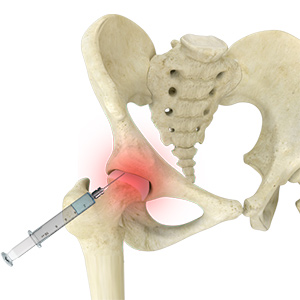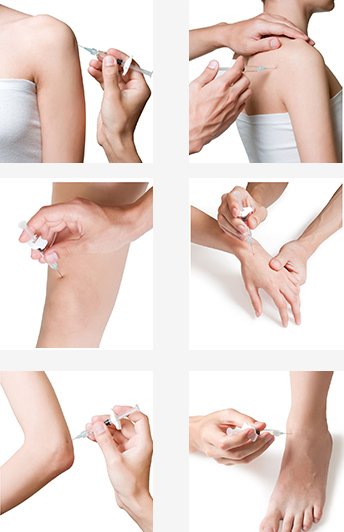Joint Injections (hip/knee/shoulder/wrist)
A common method of relieving pain from the joints is through injections. These injections are simple and are proven to have faster recovery times.

Hip Injections
Hip Injections aim to reduce pain as well as pinpointing the root of the problem. These injections can be used as both a diagnostic tool but also as pain relief. As a diagnostic tool, a local anesthetic is used to temporarily numb the painful region. If the patient feels that the pain is completely gone then the source of the problem is likely to be the joint. From this diagnosis, treatment can be discussed.
The most common treatment is using injections.
- Anesthetic is given through an IV line if the patient wants to use it during the operation.
- The patient is lying on their stomach while the back is cleaned with an antiseptic to prevent any infections.
- Fluoroscopy is used (which acts as an X-Ray) to guide the physician where to go – this way the source of the pain can be determined.
- Dye is used to showing where the medicine is traveling to and to ensure that it is only affecting the joint.
- Anesthetic and cortisone are injected into the joint.
Knee Injections
After testing oral medication against injections, researchers have argued that injections directly target the area and therefore solve the root of the problem a lot faster than painkillers.
There are three types of knee injection that a doctor may use to reduce levels of pain in the joint:
- Hyaluronic Acid
This acts as a lubricant to allowing the knee to move smoothly – reducing levels of pain. For this procedure, injections are given routinely – every week for a month in most cases.
Joint fluid sometimes has to be removed in order to insert Hyaluronic Acid into the knee.
- 2. Corticosteroid
This is a quick pain relief and can cure the problem for over 6 months in some cases. However, it works differently for different people. However, this is more dangerous than others due to the fact that it may cause cartilage breakdown.
- Arthrocentesis
This removes any excess fluid in the joint that is causing any pain – this can reduce signs of inflammation and swelling. In the space where the liquid was, some physicians will insert an anesthetic to prevent the build up of liquid again.
Shoulder Injections
If you are experiencing chronic pain in the shoulder region then typical painkillers won’t simply be enough to reduce symptoms.
Corticosteroids can be injected into the joint to relieve the pain and increase flexibility in the shoulder. These injections can only weaken symptoms, however – they are not a long-term solution to the pain.
Hyaluronate injections can also be used and injected into the shoulder. However, researchers have found that corticosteroids simply were the best treatment for shoulder pain.
Glenohumeral joint injections can be used to weaken symptoms of arthritis. A needle is inserted – there should be no resistance if in the right place of the joint – and can provide good pain relief.
Wrist Injections
The most common form of wrist injection is the use of steroid injections. These can aid problems such as carpal tunnel, arthritis, and tendonitis. Although it cannot completely cure these problems, steroid injections can weaken the symptoms.
Cortisone steroids can last for many weeks. There is a limit to how many injections a person can use, though, as too much may cause complications such as damage to tender regions such as cartilage. The steroids are injected directly into the joint that is causing pain.
For some people, the pain is reduced instantly but for others, it may take a few days.
To start the procedure, you are normally given a general anesthetic alongside the steroid to limit the amount of pain experienced. The numb feeling usually wears off within 24 hours.

Side Effects of Injections
- Infection
This is very rare and only happens to a small amount of the population.
- Swelling and Joint Pain
This is the most common side effect, however, wears off within 72 hours in the majority of cases.



